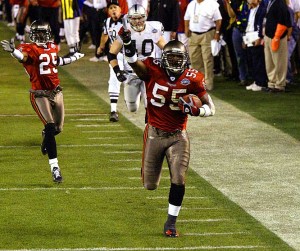After 15 weeks, I wrote that Seattle’s pass defense looked to be one of the most dominant since the merger. With the regular season now over, and the Seahawks getting ready for their first playoff game, I wanted to revisit this question and slightly tweak the methodology.
We begin with the base statistic to measure pass defenses, Adjusted Net Yards per Attempt. Team passing yards and team passing yards allowed, unlike individual passing yards, count sack yards lost against a team’s passing yards total. So to calculate ANY/A on the team level, we use the formula (Passing Yards + 20*TD – 45*INT) divided by (Attempts + Sacks). The Seahawks allowed just 3.19 ANY/A this year, which was 1.20 ANY/A better than any other defense this season. In fact, it was so good that it enabled Seattle to easily post the best ANY/A differential (offensive ANY/A minus defensive ANY/A) in the league, too. The Seahawks 3.19 average is the 4th best average in the least 20 years (behind only the 1996 Packers, 2002 Bucs, and 2008 Steelers). But what makes Seattle’s accomplishment more impressive is the passing environment of the NFL in 2013.
When I graded the Seahawks three weeks ago, I defined the league average ANY/A in the customary way: the ANY/A average of the passing totals of the league as a whole. This time around, I decided it would be more appropriate to (1) exclude each team’s own pass defense when calculating the league average, and (2) take an average of the other team’s ANY/A ratings, as opposed to taking an average of the totals. In 2013, the other 31 pass defenses allowed an average of 5.98 Adjusted Net Yards per Attempt. That means Seattle allowed 2.79 fewer ANY/A than the average team this year: that’s better than every defense since 1990 other than the 2002 Bucs.
Next, I calculated the Z-Score for each pass defense. The Z-Score simply tells us how many standard deviations from average a pass defense was. The standard deviation of the 32 pass defenses in 2013 was 0.95, which means the Seahawks were 2.93 standard deviations above average. That’s the 4th best of any defense since 1950.
[continue reading…]

